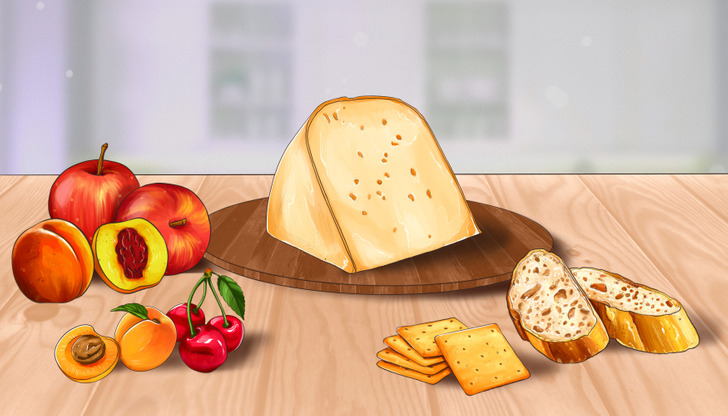How to Combine Different Kinds of Cheese With Other Foods
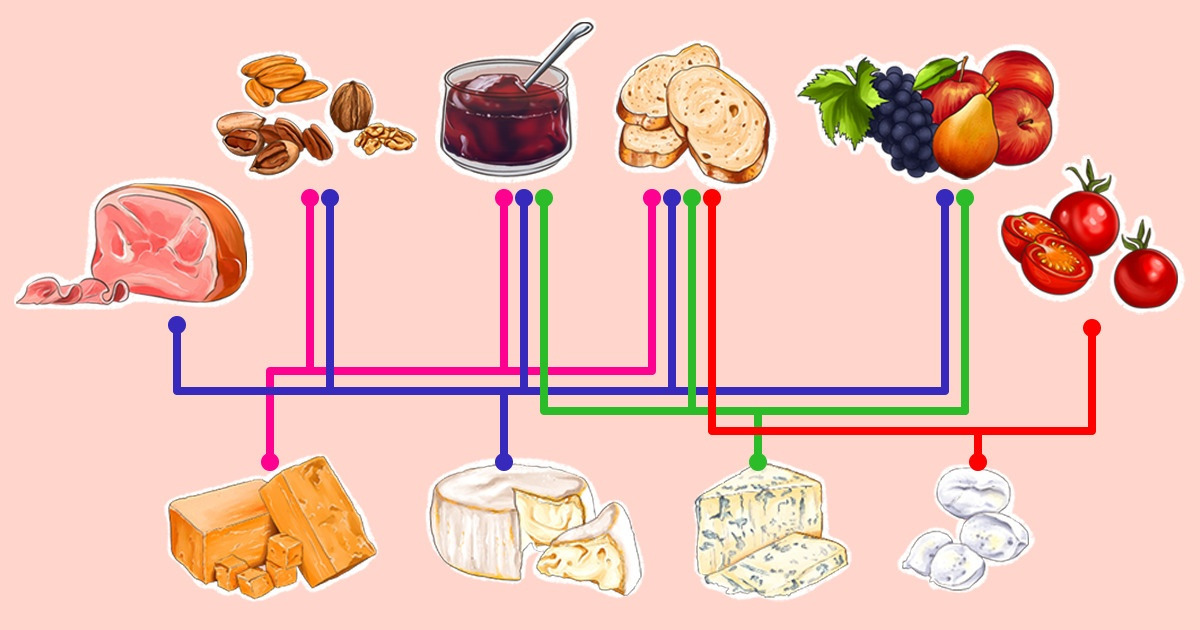
The ability to serve cheese well is an art form. Some cheeses go well with fruit, others — with tart marinated vegetables, and some are great with sweets. But if you look deep into this matter, you will see that it’s not all that hard and there are certain foods that go well with the most famous kinds of cheese.
5-Minute Crafts is going to tell you which foods go with which kinds of cheese.
Brie
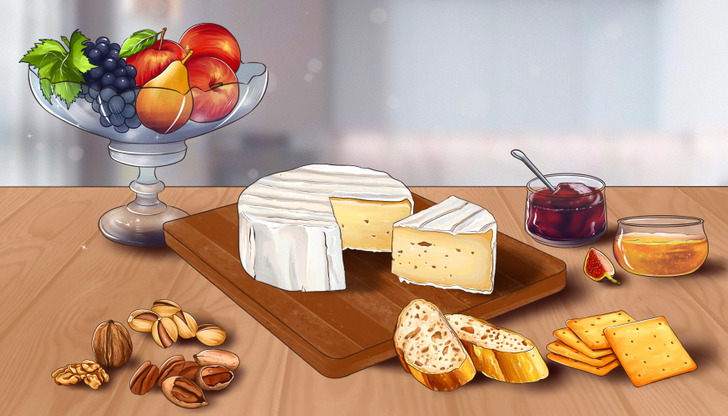
Brie is an off-white, soft-ripened cheese made from cow’s milk. It has a bloomy rind of white mold, which is considered to be a delicacy.
- Brie should be served at room temperature, so you should take the cheese out of the fridge 1 hour in advance. It will reduce the ammonia taste that might appear in the cheese when it’s kept in the fridge. You should cut the brie into small triangular pieces.
- Brie should be served with a baguette, crunchy bread, or crackers that won’t interfere with its creamy taste.
- Sweet and sour fruit will highlight the elegant taste of this cheese — try it with apples, grapes, and pears. You can also add honey, fig jam, and pecans without salt.
- Brie goes well with other cheese, so it’s a great choice for a cheese plate. Try combining it with cheddar, cheese with blue mold, and goat cheese. You can also add meat (like salami and prosciutto), marinated vegetables, and dried fruit.
❗Don’t forget that an uneven number of different cheeses should be on a cheese plate. - Baked brie is good with both sweet and spicy toppings. You can add apples, figs, oranges, cranberries, pomegranates, grapes, and dried fruit. On the savory side, you can add pistachios, pecans, garlic, parsley, mushrooms, and walnuts.
Camembert
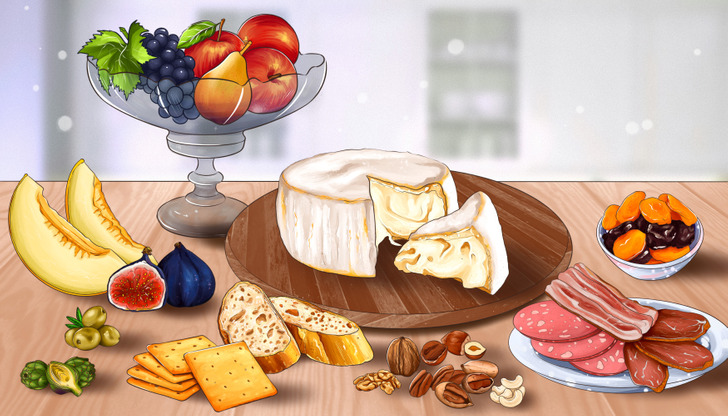
Camembert is a soft fatty cow’s milk cheese with a velvety white mold crust and a delicate creamy taste.
- Camembert is not served cold. To discover the taste and flavor, take it out of the fridge at least 1 hour in advance to give it time to warm up. After that, you can cut the cheese into triangular pieces, like a pie, and serve it. Use a knife soaked in hot water to cut the cheese.
❗Don’t put the cheese in the microwave, this will ruin its special taste. - Camembert is good with a fresh baguette, nuts, autumn fruits, and berries (melons, apples, or pears).
- You can combine this cheese with grapes, fresh honey, and barely sour berry jam.
- You can also serve camembert with dried bread: baguette, toast, ciabatta, crackers, and breadsticks. You can add fresh fruit (pears, apples, tangerines, or figs), berries (strawberries, raspberries, blackberries, or grapes), and dried fruit (apricots, pineapple, cranberries, cherries, or figs).
- To add something more nutritious, you can serve baked cheese with marinated vegetables (olives, pickles, and artichokes) and mushrooms, nuts (walnut, almond, pecan, cashew, pistachio, and hazelnut), and air-dried meat (bacon, salami, pepperoni, and prosciutto).
Cheddar
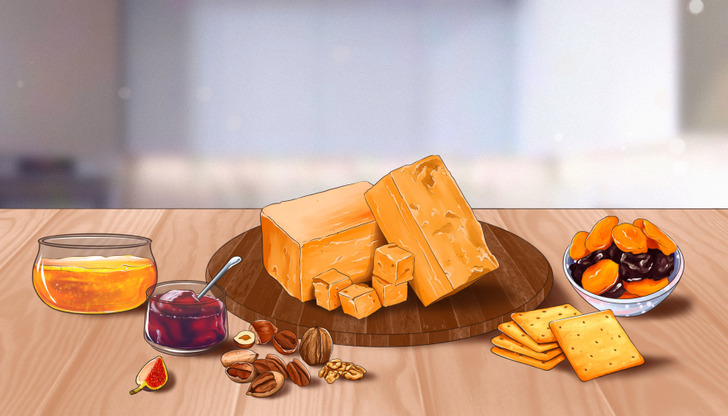
Cheddar is a firm, natural cow’s milk cheese that ranges from white to yellow or orange in color. A young cheddar has a mild flavor and becomes sharper in taste the longer it cures. During the aging process, the creamy and smooth texture becomes firm and filled with tiny crystals.
- Cheddar is good in very different combinations. Crunchy crackers, honey, and fig jam are good with it.
- You can serve cheddar on a cheese plate together with other cheeses and add jam, dried fruit, nuts, crackers, and slices of bread.
- Add a thin slice of cheddar on a piece of bread and bake them to get a nicely flavored sandwich.
- Combine cut cheese with apple pieces, or add it to pasta, potatoes, and eggs.
Feta
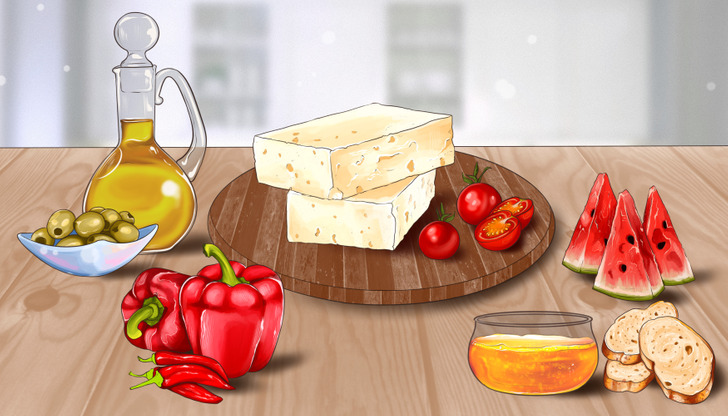
Feta is a soft, brined, white cheese traditionally made from sheep’s milk, but commonly made from a mixture of sheep’s milk, goat’s milk, or cow’s milk. Traditional feta should have the following characteristics: white color, soft, crumbly, slightly grainy texture, and salty, tangy flavor.
- Feta is universal, you can add it to a lot of different meals. On pizzas, feta is great with tomatoes, peppers, and olives, and in pies — with pumpkin, spinach, and beetroot.
- Feta can be added to salads and combined with fruit (like watermelon with mint).
- The taste of feta can add a punch to an omelet with tomatoes and spinach, in pasta — with tomatoes, olives, artichokes, parsley, and capers. It can also be added to baked potatoes or potato mash.
- Serve feta with fresh bread, salt, pepper, and olive oil.
- Feta wrapped in crispy phyllo can be baked and served with a sweet honey sauce.
Gorgonzola
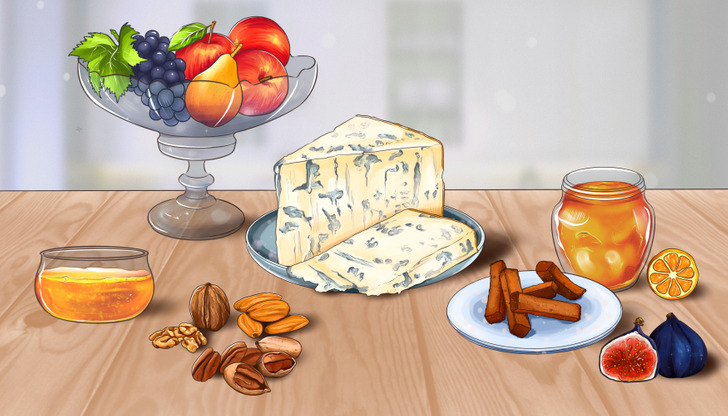
Gorgonzola is an Italian cheese traditionally made from pasteurized cow’s milk and it has the signature blue veins. It has a rich, salty, and a bit earthly smell. The texture might vary from soft and creamy to crumbly and semi-firm.
- To discover the taste of gorgonzola, keep it at room temperature for at least 30 minutes.
- Gorgonzola is good with honey and sweet jams (citrus, chestnut, or fig). You can also add pears, green apples (Granny Smith), and nuts (hazelnuts, pecans, and almonds).
- Combining gorgonzola with fruit is a classic. Try it with pears, apples, figs, and grapes.
- Blue cheese can be served with cheese croutons and garlic bread, or add it to a cheese plate.
- Gorgonzola can be added to salads, pastas, risottos, and polentas to make the meal spicier.
- It’s easily mixed with other dairy products (cream, mascarpone cheese, parmesan) and can be used to make sauces.
Gouda
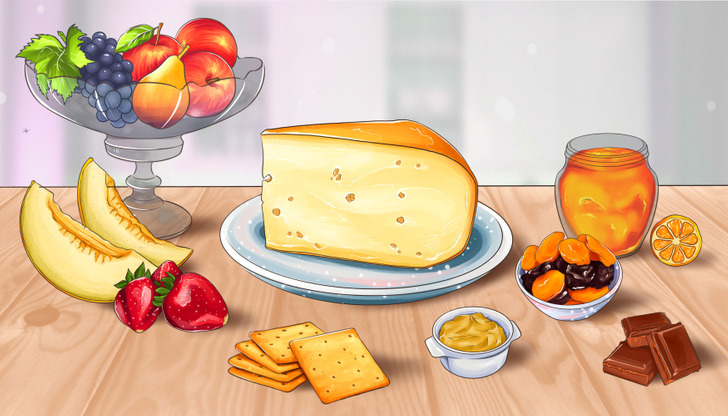
Gouda is an aged cheese with a colorful, wax-coated rind and a flavor ranging from mildly sweet and buttery when young to intensely nutty and caramelized when aged for a year or more. The texture depends on the age: young cheese can be relatively soft, and as it ages, it gets hard and more flavorful.
- Gouda goes well with a lot of different meals. You can serve it with a spoon of orange and apricot jam, crunchy crackers, mango chutney, and mustard.
- Try combining Gouda with fresh fruit and berries: grapes, strawberries, melon, and apples. The taste is great with peaches and Anjou pears.
- Gouda can be served on a cheese plate with whole-wheat bread, fresh fruit, and dried fruit.
- Gouda only really goes with salami if you want to add meat.
- Aged cheese that is sweeter and more complex is great with chocolate and brownies.
- Young Gouda is great to add to pasta, casseroles, and frittatas. Aged Gouda can be added to pasta.
- Young Gouda can be used for salads, sandwiches, and fondue.
Gruyère
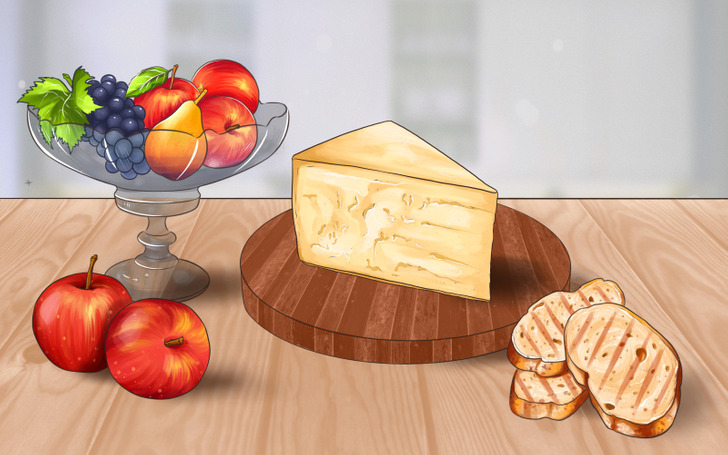
Gruyère is a firm cheese that is traditionally made from unpasteurized cow’s milk. Variations may differ in terms of taste but, in general, the taste of this cheese can be described as salty, rich, with a hint of sweetness and nuttiness.
- Gruyère can be used on a cheese plate and it’s good with apples, pears, and grapes.
- You can serve this cheese with crunchy bread or fried potatoes, or add it to pasta and salad. It’s great for adding to baked goods and French onion soup.
- It makes a great combination with Emmental cheese to make fondue or the classic French cheese sandwich, Croque Monsieur.
Mozzarella
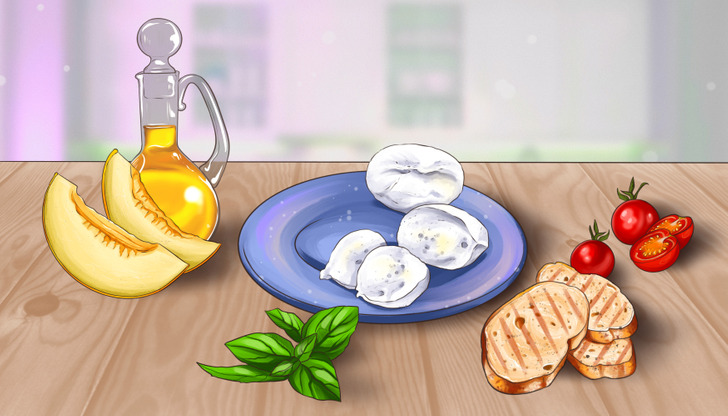
Mozzarella cheese is unripened, soft cheese. Traditionally, it was made from buffalo milk. In the USA and other European countries, it is made from cow’s milk. It should be eaten at room temperature.
- Mozzarella can be served very simply — with just a sprinkle of olive oil. You can also add pieces of melon or tomato slices.
- Mozzarella is good with tomatoes and basil which enhance the taste of each other in a Caprese salad.
- It can be great on pizzas, sandwiches, bruschettas, and be used as a filling for meat meals.
- Mozzarella can be used as an addition to pastas, soups, sauces, mashed potatoes, and casseroles. You can also add it to soufflés, omelets, and fondue.
Parmesan (Parmigiano Reggiano)
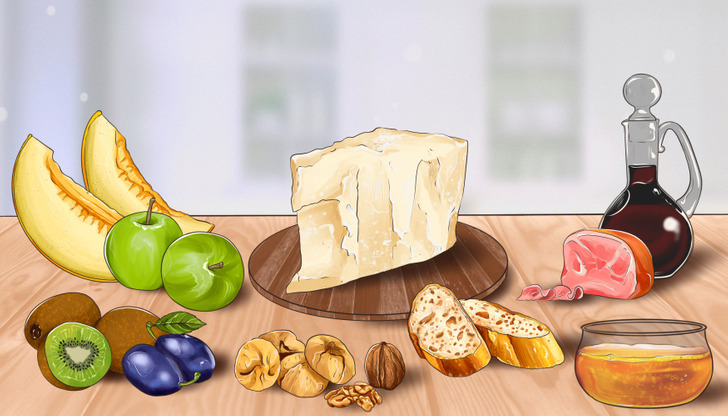
Parmigiano Reggiano is a hard Italian cheese made from skim, unpasteurized cow’s milk, with a lengthy aging process. The color may vary from pale yellow to wheat-gold, depending on the age and the taste can be salty, sweet, with hints of herbs and nuts.
- It’s recommended to get the cheese out of the fridge around 1 hour before serving to discover its taste and flavor.
- Young Parmigiano Reggiano can be served with fresh fruit, like pears or green apples. Aged cheese is better with dried figs and dried plums. It can also be served with some balsamic.
- On a cheese plate, parmesan can be served with fresh honey, prosciutto, balsamic, fresh fruit, and bread.
- Parmigiano Reggiano can be combined with fresh vegetables and summer fruit: kiwis, peaches, apricots, melons, figs, and pears. You can also add hazelnuts.
- You can make Parmigiano Reggiano chips: on parchment paper, put grated parmesan in heaps and bake it for 8-10 minutes. You can serve the chips with soups, sauces, and as a separate appetizer.
- You can add grated Parmigiano Reggiano to salads, pastas, soups, and risottos.
Roquefort
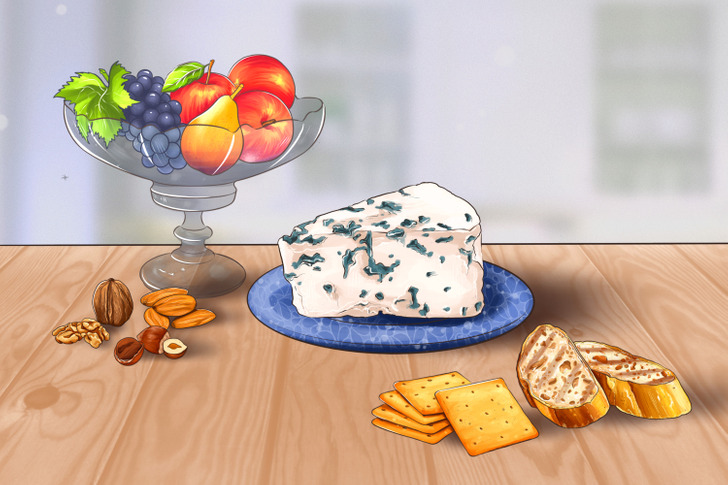
Roquefort is a cheese with blue mold made from sheep’s milk. It has a creamy texture and a complex rich and salty taste with oily bits.
- Like most cheeses, Roquefort can only show its true taste at room temperature.
- It can be served as part of a cheese plate with fresh and dried fruits, nuts, and crackers.
- You can also serve it as an addition to a toasted baguette to put on the bread.
- This cheese can be used in pizzas, sandwiches, casseroles, hamburgers, pies, and with fried vegetables.
Emmental
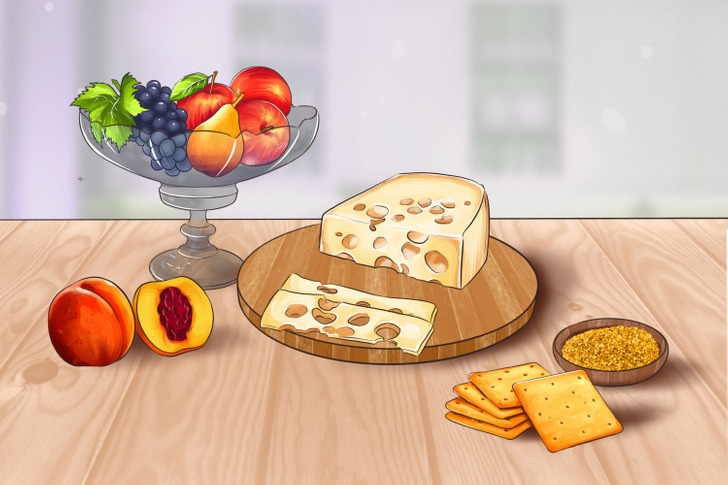
Emmental has a semi-hard texture, a mild and nutty taste, and a natural rind, however, the holes in the cheese are what make it particularly distinctive. A younger Emmental will have a mild and fruity taste, while a more mature Emmental will be full-bodied with a stronger flavor.
Edam
